The Kraken are new to the Stanley Cup Playoffs. Are you? Here’s all you need to know
- Oops!Something went wrong.Please try again later.
- Oops!Something went wrong.Please try again later.
- Oops!Something went wrong.Please try again later.
- Oops!Something went wrong.Please try again later.
- Oops!Something went wrong.Please try again later.
- Oops!Something went wrong.Please try again later.
- Oops!Something went wrong.Please try again later.
Don’t know hockey icing from that which sits atop birthday cakes?
Think a minor penalty is a false start and 5 yards?
Don’t realize Lord Stanley’s Cup is sports’ oldest championship trophy and most grueling one to earn, not something Martha Stewart sells on cable TV?
No problem. Like a shutdown penalty-killing unit, McClatchy has you covered with our Kraken Hockey School. Just in time for Seattle’s first Stanley Cup playoff games.
“Let’s keep doing things that nobody else outside this room thinks that we can accomplish,” coach Dave Hakstol told his players in the Kraken locker room April 7.
That includes teaching you about pucks.
Hakstol said that the night his Kraken went from the bottom of the National Hockey League in their concerning expansion of 2022 to playoff wonders in this, their second season.
The Kraken finished the 2022-23 regular season with 46 wins, 27 losses and 100 points in the Pacific Division. That was a 40-point improvement over last season. That earned them the first of two wild-card entries in the Western Conference playoffs.
The Kraken joined the 2017-18 Vegas Golden Knights as the only teams in the last 31 years to make the Stanley Cup playoffs within the first two years of existence.
Seattle will play games 1 and 2 of the first round at defending NHL-champion Colorado. The Avalanche won the Central Division. Games 3 and 4 of Avalanche-Kraken will be at Climate Pledge Arena, April 22 and 24, at 7 p.m. each night. If the series gets that far, game 6 would also be in Seattle, April 28.

In addition to national coverage on ESPN, ABC, TNT and TBS, all Kraken first-round game will be shown locally on cable’s ROOT Sports.
Here are the keys, the key players and the basics of how to watch the Kraken in these playoffs:
Keys to winning the Stanley Cup
Unlike in Major League Baseball or the National Basketball Association, every step of the NHL’s two-month postseason from next week’s first round through the Stanley Cup Finals are grinding, best-of-seven series. The first team to four wins advances.
The keys to winning the Stanley Cup, first awarded in 1893 (!) and with more than 2,400 names engraved on it: Extraordinary goaltending (a goalie “standing on his head”) and winning on the road.
The Kraken have proven they can do the latter.
Whether they get the former will define their postseason.
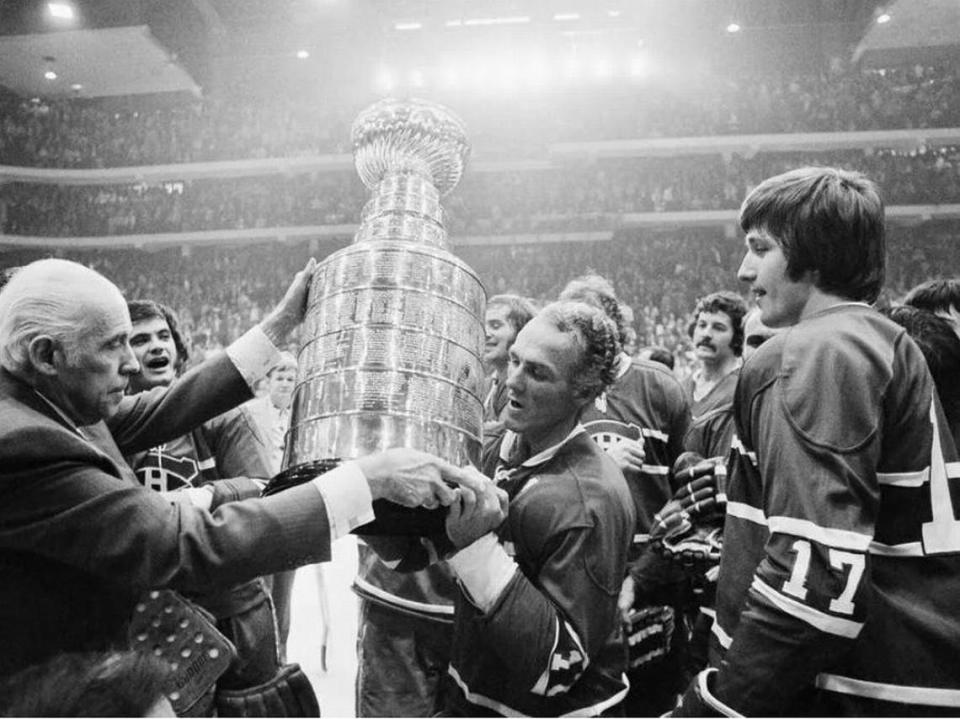
Yes, the first two games of Seattle’s playoffs are in Colorado. The Avalanche have the home-ice advantage for four of the seven games if the first-round series goes the distance.
But the Kraken had 26 wins plus four overtime points in 41 away games. That’s six more regular-season victories than they had at home. Seattle won both its games at Colorado this season, 3-2 victories in October and early March.
The Avalanche won the only meeting in Seattle, 2-1 in a shootout after a scoreless overtime in January.
Only Colorado, New Jersey, Edmonton and Boston had more road wins than Seattle. The Bruins set an NHL record with 65 overall wins this season. They are the favorites to win it all in June.
rly feeling this new decor #SEAKraken pic.twitter.com/XBPuhnMAo3
— Climate Pledge Arena (@ClimateArena) April 13, 2023
Grubauer and Jones
Veteran goaltender Philipp Grubauer started 54 games last season, but only 36 this season. At times he alternated starts with Martin Jones.
Jones lost only five of his first 27 starts this season. It was Jones in goal for the Kraken’s best win of the season, a 3-0 throttling of the Bruins in mid-January. Jones’ third shutout this season was the Bruins’ first home regulation loss and just one of four defeats all season for them in Boston.
Grubauer’s .895 save percentage this season was the second-lowest of the German’s 11-year NHL career. His 2.85 goals-against average was only 20th in the league. But the former Avalanche goalie won four of five starts for the Kraken into this past week. That was while Jones had an injured hand from playing last weekend in a home win over Chicago. Joey Daccord was an emergency call-up from the minor league to backup Grubauer at the end of the regular season.
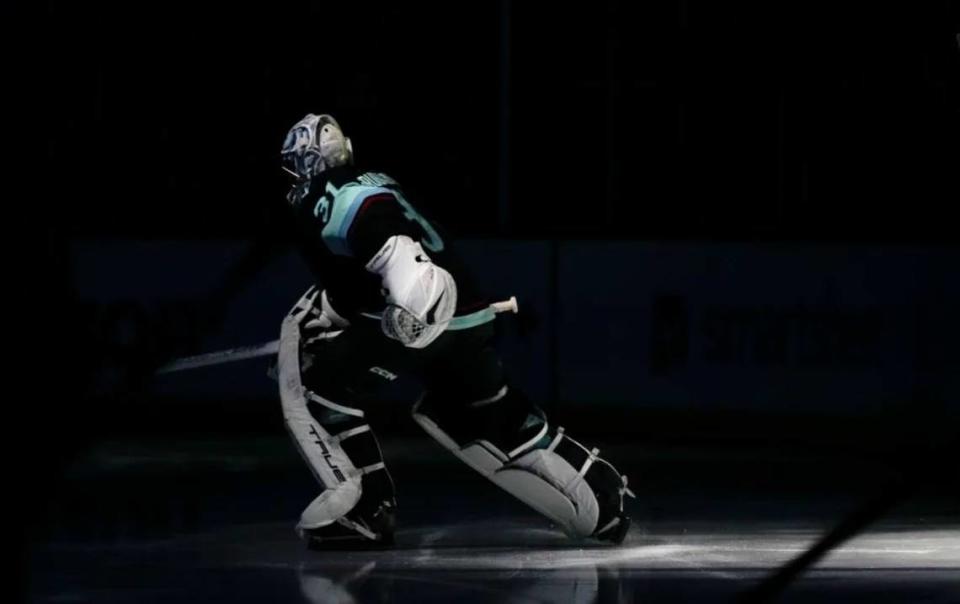
Grubauer is the healthier, hotter goalie entering the playoffs. But he’s been pulled before in the postseason. Washington benched him in the first round of the 2018 playoffs after he allowed eight goals in less than two full games. Those Capitals went on to win the Cup with Grubauer watching his replacement Braden Holtby get hot.
Grubauer advanced into the second round of the playoffs with Colorado in 2019 and ‘21. He’s never gone further than that as a starter.
If Grubauer struggles against the Avalanche, Hakstol knows Jones can and has won for these Kraken against the NHL’s best this season.
If Jones is healthy enough to play this postseason, that is.

Matty Beniers, stud rookie
The Kraken’s lone All-Star is their 20-year-old phenom center, Matty Beniers. He’s fast. He skates like sprinters run.
In fact, pause while you are watching the games to admire the skating skill of NHL players. The athleticism required to accelerate, turn, stop, put a stick to a zooming puck, check opponents, avoid opponents and, yes, fight while staying balanced atop two thin metal blades across a sheet of unwalkable ice is amazing.
The smaller (178 pounds) Beniers had three goals in four games after scoring Monday at Arizona. That was his 24th goal of the season, the most of any NHL rookie. He’s likely to win the Calder Memorial Trophy as the league’s rookie of the year.
Beniers was the Kraken’s first draft choice in franchise history, the second-overall pick in the 2021 NHL draft.

The Avalanche are among the league leaders in fewest goals allowed this season. They are likely to focus their defense on Beniers. They likely will attempt to be physical with Beniers and have 6-foot-5, 233-pound defenseman Kurtis MacDermid shadow him.
“Beniers will go through new experiences over the next couple weeks,” Hakstol said.
“Those are going to be the ones, quite honestly, I expect him to excel through.”
But the Kraken have other scoring threats. No NHL team was better in spreading goals around than Seattle. Jared McCann led the Kraken with 40 goals. Beniers had his 24. Jaden Schwartz and Daniel Sprong each had 21. Jordan Eberle and Oliver Bjorkstrand each scored 20 goals.
Seattle tied with Dallas, Ottawa and Pittsburgh for the most players in the league with at least 20 goals this season.
The Kraken set an NHL record for most players with two or more game-winning goals in a season, 15.
Bjorkstrand got his 20th goal Monday in Seattle’s 4-1 win at Arizona. That victory got the Kraken equal to the 2017-18 Golden Knights as the only NHL teams with 100 points within the first two seasons of franchise existence. Bjorkstrand’s milestone goal came days after the 28-year-old winger and his wife Jill celebrated the birth of their first child, Otto.
Congratulations to Oliver and Jill Bjorkstrand on the birth of their first child!
Otto is absolutely perfect!
(: The Bjorkstrand family) pic.twitter.com/tZZyd0MT1m— x - Seattle Kraken (@SeattleKraken) April 8, 2023
Yes, Ollie’s son is Otto. Hockey players are cool.
A large amount of them grew up on prairies and ponds in small-town Canada. They are as real to talk to as it gets in professional sports.
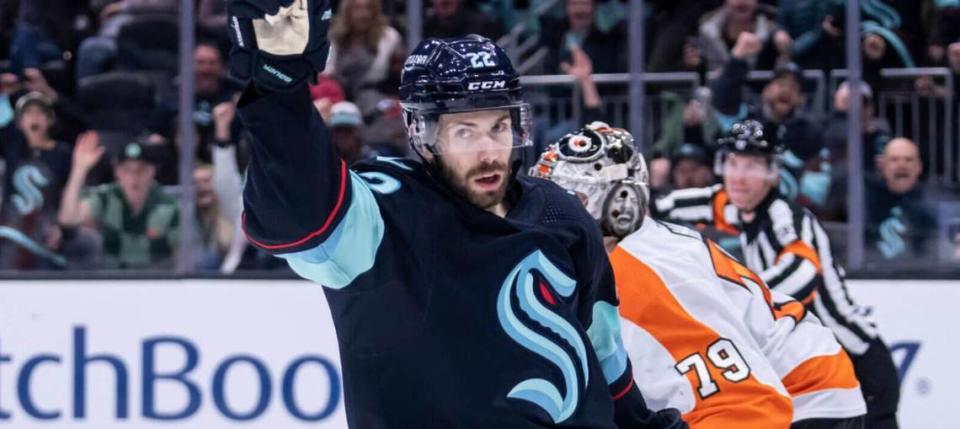
The blue lines, icing, more
OK, to the rules.
What are those painted lines, red and blue, across the ice?
The checkered red line is center ice, the midline of the NHL’s 200-foot-by-85-foot rink. The opening face-off to begin the game, and face-offs after goals, happen at the red dot in the center of the circle and red line.
There are also red goal lines that stretch from board to board across the mouth of each goal. The puck has to completely cross the goal line to be scored a goal.
The blue lines define whether each offensive, attack zone is toward each goal. The area between the blue lines across center ice is the “neutral zone.”
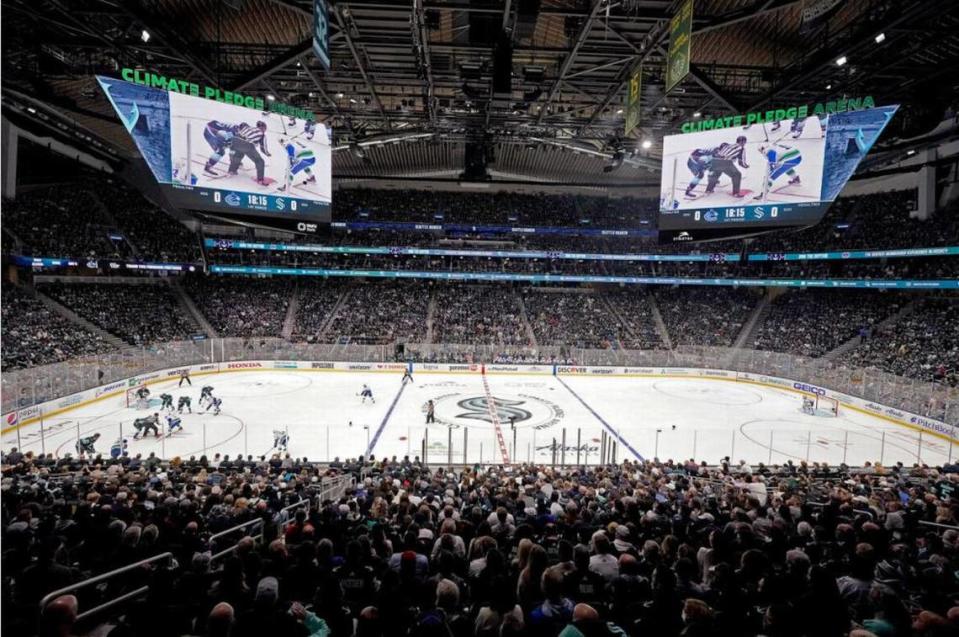
At the blue lines are where postseason games are won and lost.
Former 16-year NHL veteran center Eddie Olczyk, an analyst on the Kraken’s television network, explained it this way during a Seattle game broadcast last week: “Come playoff time, blue lines become the key. Gotta get the puck in at the opponent’s blue line. And you’ve gotta get the puck out (past your own).”
Hockey rules say the puck or puck carrier must precede all other attacking players across the blue line into the offensive zone. If another attacker goes in first, one of the two linesmen officials (the ones without the orange arm bands; those are the two referees) call offside. Both skates of an offending players must be completely inside the blue line before the puck for offsides. Face-offs, the drop of the puck between two opposing players after stoppages in play, occur after offsides on the nearest red dot outside the blue line where the infraction occurred.
Icing is called when a player hits a puck with his stick forward and long across the center red line, across the opposite blue line and across the opposite goal line. The subsequent face off is in the defensive zone (that is, inside the defensive blue line) of the team that iced the puck.
Icing does not apply when a team is playing shorthanded. When a team is down a man or men because of a penalty, they can and often do fire the puck the length of the ice to get the puck far away from the attackers and attacking zone.
Penalties
There are three classes of penalties: minor (2 minutes), major (5 minutes) and misconduct (10 minutes or ejection).
The vast majority of penalties called in an NHL game are minor. They include:
hooking (with the crook of the curved stick into the body of an opponent)
holding
tripping
slashing (hitting an opponent with a stick)
interference (checking or impeding an opponent while not playing or near the puck)
high-sticking
cross-checking (in the back with the stick)
boarding (pushing a player into the side or end boards, usually from behind)
roughing (a short, minor scuffle short of a full-on fight)
delay of game (shooting the puck over the glass into the crowd)
too many men on the ice
Delay of game happens when a player shoots the puck, intentionally or not, over the plexiglass above the side boards and into the crowd.
Too many men on the ice is when a team is changing players from the bench “on the fly,” while the puck is still in play, and the changing team handles and passes the puck while more than five skaters (not including the goaltender) for that team are on the ice.
Why do players sometimes just fire the puck into the other team’s end then skate away?
Line changes.
Players take “shifts,” time on the ice, that usually don’t last longer than 60 seconds at a time. At the end of a shift, teams often dump the puck into the other team’s end, away from danger, then chase off to the bench while five new players replace them on the fly for the next shift, while the puck and thus scoring danger isn’t near their team’s net.
Major penalties include high-sticking that causes the opponent to bleed in the face or neck, violent boarding and fighting — basically anything that causes an imminent threat of injury.
Misconduct penalties are basic, game and gross misconduct. Basic misconduct, such as for berating an official, gets a guy 10 minutes in the penalty box. Game misconducts, often for fighting or an egregious hit causing injury, mean ejection, fines and possible league suspension. Gross misconduct is an ejection, fine and NHL punishment.
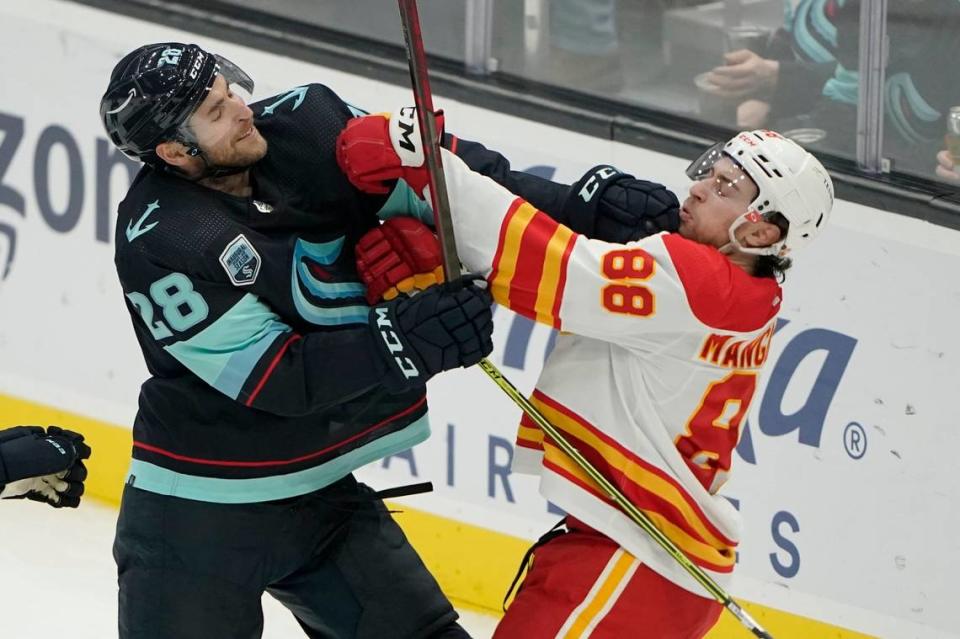
A penalty results in a “power play” for the team benefiting from a penalty. For minor penalties, that means five players against four, for 2 minutes. Coincidental minors mean one player for each team getting a minor penalties, and teams play four on four.
If a team scores on a power play for a minor penalty, the offending player gets to leave the penalty box and teams return to playing at full strength, five on five.
The league average is three power plays per team per game, so that’s six total penalties called per match, on average. The NHL average of scoring on power plays is 21.3%. Not allowing a goal on a power play is called killing a penalty.
Power-play and penalty-killing units are known as hockey’s special teams. Coaches usually group their best offensive players from different lines, or shift groups, onto power-play units, and their best defensive players onto penalty-killing units.
The Kraken will likely need to improve their special teams to advance far in these playoffs.
Seattle was 19th in power-play success this regular season, scoring goals 20.3% of the time, just under the league average.
The Kraken were 21st in the NHL in penalty killing during the regular season, allowing goals 76.7% of the time when down a man. But Seattle improved dramatically late. The team was third in the league in penalty killing after mid-February.
Overtime in playoffs
If the game is tied after three, 20-minute periods, it goes to sudden-death overtime in the playoffs. That means they play until a goal is scored. Each overtime period is 20 minutes, with an intermission between them that is a little shorter than regulation intermissions.
The NHL playoff record for longest game is six overtimes, 116 minutes, in the league semifinals between the Detroit Red Wings and Montreal Maroons March 24, 1936. More recently, Tampa Bay and Columbus played five overtimes in 2020.
The lead is a good thing
When leading after two periods, the Kraken were 35-1-3 in the regular season.
Three is usually enough
The Kraken were 45-6-1 when scoring at least three goals in a game this season.
Kraken playoff schedule
First round, Western Conference playoffs, best of seven:
Game 1: Tuesday, April 18 at Colorado, 7 p.m., ESPN, ROOT Sports
Game 2: Thursday, April 20 at Colorado, 6:30 p.m., ESPN, ROOT Sports
Game 3: Saturday, April 22, at Climate Pledge Arena, 7 p.m., TBS, ROOT Sports
Game 4: Monday, April 24, at Climate Pledge Arena, 7 p.m., TBS, ROOT Sports
Game 5 (if necessary): Wednesday, April 26, at Colorado, ROOT Sports
Game 6 (if necessary): Friday, April 28, at Climate Pledge Arena, ROOT Sports
Game 7 (if necessary): Sunday, April 30, at Colorado, ROOT Sports

